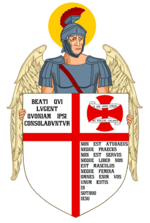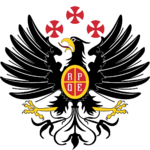Etrurian First Republic
Etrurian Republic Republic of Heaven Reppublica Etruriana Repubblica del Cielo | |
|---|---|
Motto:
| |
Anthem:
| |
| Capital | Tyrrenhus (1784-1787) Solaria (1787-1810) |
| Religion | Solarian Catholicism |
| Demonym(s) | Etrurian |
| Government | Directorial republic (1784-1785) Theo-directorial republic (1785-1810) |
| President of the Convention | |
• 1784 | Aurelio Polizzi |
| Member of the Aventine Triad | |
• 1784-1785 | Francesco Cassio Caciarelli |
• 1784-1785 | Massimiliano Malaspina |
• 1784-1785 | Giovanni-Paolo Danova |
| First Citizen | |
• 1785-1810 | Francesco Cassio Caciarelli |
| Legislature | Senate of the Republic |
| History | |
• Established | 20 January 1784 |
| 9 September 1783 | |
| 3 November 1783 | |
| 20 January 1784 | |
| 10 July 1784 | |
• La Purga | 18 July 1784 |
| 20 July 1784 | |
| 12 August 1810 | |
| Population | |
• 1784 | 18,398,200 |
• 1810 | 19,998,200 |
| Currency | Etrurian piastra |
| Today part of | Etruria Gaullica Piraea Galenia |
The Etrurian First Republic (Prima Repubblica Etruriana), officially known as the Etrurian Republic (Repubblica Etruriana) and co-officially known as the Republic of Heaven (Repubblica del Cielo), was founded on 20 September 1784, during the Etrurian Revolution. The First Republic would end with the Caltrini Restoration on 18 August 1810. Throughout most of its existence, the First Republic was governed by the Pantheonisti faction, under a theocratic directorial republican system. The period of the First Republic was characterised by the overthrow of the Grand Principality of Tyrrenhus, the establishment of the Popular Convention, the Aventine Triad, the Pantheonisti led La Purga, its subsequent domination, the Republic of Heaven period, the Revolutionary Wars, La Tempesta and finally, its demise with the Caltrini Reactions and the Caltrini Restoration.
The First Republic would leave a profound legacy in both Etruria and the wider world, ideologically, politically, economically and religiously. It united the territories of Etruria for the first time since Solarian times and would export its unique theocratic republicanism across much of Southern Euclea, leaving an indelible mark on the evolution of the Catholic Church. In comparison to its rival Weranic Republic, the Etrurian Republic’s ideals and principles of popular universal suffrage, utilitarianism, egalitarianism and a Catholicism-infused Etrurian nationalism, would live on almost a century through the clergy and academic circles, ultimately being reconstituted in some form with the Etrurian Second Republic, following the San Sepulchro Revolution in 1888 that overthrew the Caltrini monarchy.


